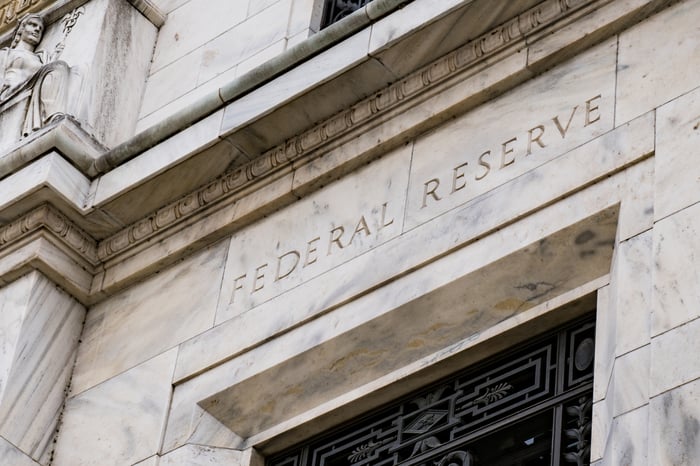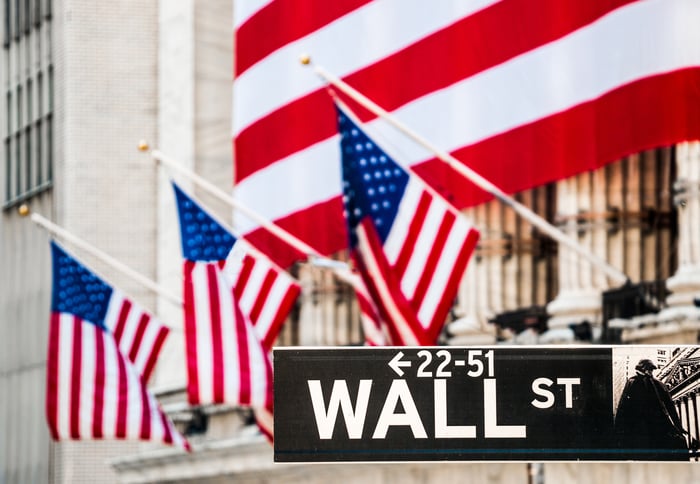It's a brand-new year, and boy, does 2020 have some big shoes to fill. Last year, we witnessed the benchmark S&P 500 (^GSPC -0.88%) gallop higher by nearly 29%, which is quadruple the historic average annual return of the stock market, inclusive of dividend reinvestment and when adjusted for inflation.
The big question, of course, is what might the current year hold for the broader market and investors? The following 20 predictions for the stock market in 2020 may offer some insight.

Image source: Getty Images.
1. There will be no recession in 2020
Probably the biggest question on investors' minds is whether a recession is brewing. While that does look to be the case following a very brief inversion of the two-year and 10-year Treasury bonds in late August, data from Credit Suisse, dating back to 1978, shows that the average recession doesn't pop up until 22 months after the inversion occurs. Similarly, stock market returns don't turn negative until an average of 18 months after an inversion, putting the market on track to lose its steam during the first quarter of 2021 (assuming these averages hold true).
For the time being, the longest economic expansion in U.S. history looks poised to continue.

Image source: Getty Images.
2. The stock market will have another positive year
Despite the stock market delivering returns that were well above the historic norms in 2019, this year should deliver more gains to investors. Historical annual return data shows that the stock market tends to do very well in years following at least a 20% gain. Since 1981, there have been 11 years where the S&P 500 ended up at least 20% (not including rounding). In only one instance (1990) did we see the S&P 500 finish lower the following year. In fact, in a majority of these 11 instances, the S&P 500 wound up tacking on another double-digit percentage gain the following year.

Image source: Getty Images.
3. The market will experience at least a 10% correction
However, just because the data suggests the broader market will rise in 2020, it doesn't mean we're going to head straight up. Over the past 70 years, the S&P 500 has undergone 37 corrections of at least 10% (not including rounding), and many more if you count those in the 8%-9.9% range. It's a rarity when we escape a given year without at least one good scare or shakeout, and I don't believe 2020 will be an exception. With plenty of uncertainty still on the table, including the U.S.-China trade war, a correction of at least 10% in the S&P 500 has a better chance of occurring than not occurring in 2020.

Image source: Getty Images.
4. Interest rates will remain unchanged the entire year
After tugging at the heartstrings of investors for the past four years, it's my prediction that the Federal Reserve will sit on its hands the entire year and allow its three quarter-point (75 basis points, in aggregate) rate cuts enacted in 2019 to work their way into the system. Fed Chairman Jerome Powell and his Board of Governors appear cautiously optimistic on the U.S. economy, but have blatantly suggested they're in wait-and-see mode. This would mark the first full year of interest rate inaction for the Fed since 2014.
With interest rates still well below historic norms, and expected to stay there for the foreseeable future, heavily indebted industries, such as airlines and telecom, will continue to have access to cheap capital.

Image source: Getty Images.
5. Gold and silver will outperform, once again
Despite turning in substantive gains in 2019, physical gold and silver are both primed for another lustrous year in 2020. Although we typically think of gold and silver as being safe-haven investments that are flocked to during periods of uncertainty, the biggest catalyst for precious metals continues to be an extremely low-yield environment. With bank CDs and Treasury notes struggling to keep up with the inflation rate, precious metals like gold and silver, which have no yield, should remain an attractive alternative to fixed-income assets.

Berkshire Hathaway CEO Warren Buffett at this company's annual shareholder meeting. Image source: The Motley Fool.
6. Warren Buffett will make a big purchase
After sitting on his laurels for more than 3.5 years and allowing Berkshire Hathaway's cash pile to grow to a record $128.2 billion, as of the end of September, 2020 will be the year that Buffett finally makes a large purchase.
While I'd personally like to see the Oracle of Omaha buy a game-changing growth company, such as robotic-assisted surgical device developer Intuitive Surgical, history shows that he's far likelier to purchase a company in the financial or consumer staples arena, which is where he devotes most of his research. Perhaps a spice and condiment giant like McCormick is on the radar, or Buffett could simply acquire what Berkshire doesn't already own of South American payment processing company StoneCo. The possibilities are seemingly limitless.

Image source: Getty Images.
7. Healthcare will be the hottest sector in the S&P 500
Although this might be hard to believe, the second worst-performing sector within the S&P 500 in 2019 was healthcare, with only the energy sector logging a worse gain. As we move headlong into 2020, I'll be looking for healthcare to lead the charge higher.
With so many investors looking for a reason to be worried about a recession, it's only logical they'd turn to a recession-resistant industry. After all, we don't get to decide when we get sick or what ailment we develop. This makes healthcare a sector with predictable demand but plenty of growth being derived from novel drugs, medical devices, and personalized technology.
What's more, industries within healthcare, such as biotechnology, are valued near their lowest forward price-to-earnings ratios in at least two decades. There's plenty of room for earnings multiple expansion among biotech, pharmaceuticals, healthcare services, and healthcare distributor stocks.

Image source: Amazon.
8. FAANG stocks will outperform the benchmark S&P 500, as a whole...
The FAANG stocks -- that's Facebook (META -4.13%), Apple, Amazon, Netflix (NFLX -9.09%), and Google, which is now a subsidiary of Alphabet -- have substantially outperformed the benchmark S&P 500 over the past decade. I expect that trend will continue in 2020, when taken as a whole.
Though they're often sought after for their incredible growth and market share in their respective industries, most of the FAANG stocks are now valued at reasonably attractive levels relative to their cash flow potential. While I wouldn't go so far as to refer to them as value stocks, there's definitely a more convincing value argument than there's ever been. Amazon, for instance, has traded at an average price-to-cash-flow of 30 over the past five years, yet is valued at only 20 times Wall Street's price-to-cash-flow estimate for 2020.

Image source: Netflix.
9. ...But Netflix will finish the year lower
However, one FAANG stock looks as if it'll end 2020 lower: Netflix.
In a game of "which one doesn't belong?" Netflix is the only FAANG stock to currently have a net-cash outflow. This has to do with Netflix pouring all of its operating cash flow back into the business to expand its international reach.
It's also set to face a host of new competition. The emergence of a boatload of new streaming services between Nov. 2019 and May 2020, including Disney+ from Walt Disney, Apple TV+ from Apple, HBO Max from AT&T (T 1.10%), and Peacock from NBCUniversal, along with existing competition from the likes of Amazon Prime Video and Alphabet's YouTube TV, could provide more pressure to Netflix's domestic streaming business than the company has ever seen. I'm not expecting 2020 to be a banner year for Netflix.

Image source: Getty Images.
10. Bitcoin will lose half of its market value... again
Following a nearly $3,500 per-coin rally in 2019, I'll be looking for flagship cryptocurrency bitcoin to lose at least half of its value in 2020.
Bitcoin's big rally in 2019 looks to have been fueled by the expected halving of the block reward for cryptocurrency miners in May 2020. We witnessed a similar rally in bitcoin prior to the previous block reward halving in July 2016, with miners attempting to lock in as high of a reward as possible for proofing blockchain transactions.
Unfortunately for bitcoin, the catalysts look few and far between beyond May. Bitcoin's underlying technology, blockchain, hasn't taken off at the enterprise level as planned, and bitcoin itself is a fundamentally flawed investment. And, as the icing on the cake, the Securities and Exchange Commission remains leery of bitcoin and has yet to authorize a bitcoin-based exchange-traded fund. In other words, avoid bitcoin in 2020!

Image source: Getty Images.
11. A 900-plus-store retailer will go bankrupt
Pretty much every year we witness a storied business go bankrupt. Last year, embattled electric utility PG&E and mall-based retailer Forever 21 filed for bankruptcy protection, while in 2018 it was childhood favorite Toys R Us. In 2020, my expectation is that 58-year-old home furnishings retailer Pier 1 Imports (PIRRQ) cries uncle and goes bankrupt.
Fundamentally, Pier 1 is a complete mess. It's lost over $182 million over the past six months, and reported a same-store comparable sales decline of 12.6% in its fiscal second quarter. It simply can't compete with online retailers like Amazon and Wayfair, and the company's income statement shows it.
Worst of all, current liabilities are outpacing current assets by roughly $75 million. In layman's terms, it's unclear if Pier 1 will be able to pay its operating expenses and debts over the next 12 months.

Image source: Getty Images.
12. Brexit will finally happen
After more than three and a half years of indecision in Parliament, Britain will finally see Brexit become a reality in 2020.
Following a vote from residents in June 2016 to leave the European Union, former Prime Minister Theresa May tried and failed on three separate occasions to get a Brexit measure approved by Parliament. That will, most likely, not be the case with current Prime Minister Boris Johnson. That's because Johnson's conservative Tory party won a number of key seats in northern England, the Midlands, and Wales, in the Dec. 12, 2019, election. These seats had been held by members of the Labour Party. With key opposition now removed, Brexit has a clear path to occur this year, with or without a deal in place.
The big question now is: Can the U.K. stave off a recession once it does leave the EU?

Image source: Getty Images.
13. Marijuana industry M&A will come to a complete halt
Marijuana stocks were expected to take the next step in their maturation process in 2019, but were ultimately derailed by supply issues in Canada, high tax rates in the U.S., and a persistent black market presence throughout North America. But the biggest surprise in the new year just might be a complete stoppage in merger and acquisition (M&A) activity.
Following what seemed like open season for M&A since 2018 began, a number of deals have recently been amended or terminated, including MedMen Enterprises' now shelved deal to buy privately held multistate operator PharmaCann. With financing a major concern for pot stocks, especially those in the U.S. because of the illegality of cannabis at the federal level, it wouldn't be surprising to see M&A activity completely stop in 2020 as the industry looks to conserve capital.

Image source: Getty Images.
14. More pot stocks will be delisted than uplisted to a major U.S. exchange
One of the few bright spots for cannabis stocks last year was that a handful of companies were able to uplist from the over-the-counter exchange to either the New York Stock Exchange (NYSE) or Nasdaq. Being listed on a major exchange next to time-tested companies can improve visibility, volume-based liquidity, and entice Wall Street firms to offer coverage or even make an investment.
But it wouldn't be in the least bit surprising if more pot stocks were delisted than the number that uplist in 2020. For example, CannTrust is currently below the minimum share price required for listing on the NYSE and it hasn't reported its operating results since May. Meanwhile, HEXO and Aurora Cannabis are both less than $1 away from also dipping below the $1 share price required for continued NYSE listing.

Image source: Getty Images.
15. Corporate share buybacks will fall from 2019's record levels
The passage of the Tax Cuts and Jobs Act in December 2017 wound up reducing corporate tax rates and significantly boosted the amount of income businesses were able to keep. This, in turn, led to record amounts of corporate share repurchases in 2018, and again in 2019. My expectation is that 2020 will break this trend, with share buybacks falling from 2019's record levels.
Although the TCJA is still allowing companies to hold on to more of their profits, a sustainably low interest rate environment has encouraged lending and steadily increased corporate leverage over time. With recessionary fears swirling, it wouldn't be outlandish to expect businesses to pay down some of their debt in the current year instead of boosting share repurchases.

Image source: Getty Images.
16. United Technologies will be kicked out of the Dow Jones Industrial Average
Since the Dow Jones Industrial Average (^DJI 0.56%) debuted more than 123 years ago, there have been 54 times where its components have changed. I suspect 2020 will mark the 55th occasion, with aerospace and defense giant United Technologies (RTX 0.84%) getting the heave-ho.
For those not following United Technologies all that closely, it's in the process of merging its aerospace and defense segment with Raytheon, and eventually spinning off its Carrier and Otis operating divisions in separate transactions. The problem is, the Dow already has aerospace and defense representation from Boeing, making United Technologies likely expendable. This merger is expected to be complete by the first half of 2020, pending regulatory approval.

Image source: Facebook.
17. Facebook or Costco will replace United Technologies in the Dow
That's right -- a prediction of a prediction! Assuming my initial prognostication is accurate and United Technologies is removed from the Dow, the committee will need to replace it. My expectation is that either Facebook or Costco Wholesale (COST -0.24%) will fill that role.
Social media kingpin Facebook is a logical choice as the fifth-largest publicly traded company. Controlling four of the seven most-visited social media assets (Facebook, Messenger, WhatsApp, and Instagram), Facebook is able to secure more eyeballs for its advertisers than any other company on the planet. The only real knock here is that the Dow already has healthy representation from the tech sector.
On the other hand, Costco could be the perfect dark horse candidate. Even with Coca-Cola and McDonald's already part of the Dow 30, neither of these food and beverage companies tells us much about consumer buying habits or the health of the U.S. economy. But $130 billion market cap membership club Costco does exactly this.

Image source: Getty Images.
18. Restaurant stocks will significantly underperform the broader market
Although the restaurant industry has been booming, thanks to a record-setting economic expansion, I'll be looking for investors to be placing their to-go orders to get away from restaurant stocks in 2020.
You see, based on data provided by analytics company Yardeni Research, the average forward P/E ratio of restaurant companies in the S&P 500 pretty much hit an all-time high in 2019, dating back to 1997. Restaurant stocks have no businesses being valued at north of 25 times next year's earnings when their growth rates are more commonly in the low-to-mid single-digits.
Additionally, restaurant stocks are an especially dicey investment with corporate leverage on the rise and given the likelihood that we're in the later innings of the existing economic expansion. When the next recession does rear its head, the high premium of restaurant stocks should be among the first casualties.

Image source: Pinterest.
19. Pinterest will shine in 2020 -- other second-year stocks, not so much
With few exceptions, high-profile initial public offerings (IPO) face-planted in 2019. This weakness is likely to continue in 2020 as U.S. GDP growth tapers a bit. Loss-producing IPOs, such as ridesharing giants Uber and Lyft, could continue to hit the skids.
However, Pinterest (PINS -1.55%) has the makings of a major year-two rebound. Pinterest's monthly active user (MAU) count grew to 322 million by the end of September, up 71 million from the prior-year period. Growing MAU is important because it brings in new advertisers and pushes the ad-pricing pendulum ever more in Pinterest's favor. Plus, with the company pushing into overseas markets and seeing higher average revenue per user for its efforts, profitability appears to be right around the corner. I'm expecting Pinterest to be the standout of last year's IPO class.

Image source: Getty Images.
20. Value stocks stage a comeback
For about a decade, growth stocks have run circles around value stocks. Exceptionally low interest rates have provided high-growth companies with cheap access to capital, thereby fueling their expansion. But 2020 should bring a shift to this trend, even with lending rates remaining low.
It's no secret that Wall Street and investors are on heightened recession watch following the brief inversion of the yield curve in August. In my view, this means an added focus from investors on profitable and perceived-to-be cheap stocks. We've already witnessed a number of what you might call "boring companies," such as AT&T, outpacing gains in the benchmark S&P 500 in 2019. I suspect we'll see more basic-need and brand-name companies thriving this year, with growth stocks taking a back seat to value stocks for the first time in a while.

Image source: Getty Images.
Predictions aside, this is as close to a guarantee as you'll get
Chances are that, by the end of 2020, some of these prognostications will be proven true, and others will be laughed at as outlandish. But when it comes to the stock market, there's truly only one guarantee that you need to know: Buying and holding great companies for a long period of time is a good recipe to make money.
As noted, despite 37 stock market corrections in the S&P 500 since the beginning of 1950, each and every correction has been completely erased by a bull-market rally. In fact, more than half of all stock market corrections take just months to find a bottom and result in new highs not terribly long thereafter. In other words, if you buy great companies and hang onto them over long periods of time, you should come out a winner.





